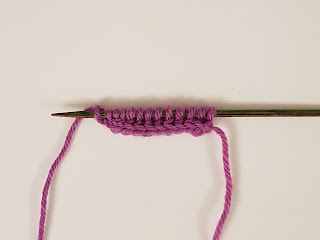Happy knitting everyone! Today I’d like to share a useful technique – I-cord cast on.
"I-cord cast on" helps to start your knitting with beautiful cord along the edge of knitted piece and prevents it from rolling. I-cord cast on can be used for neat neck edge for top-down knitted sweaters, beautiful bottom edge for bottom up sweaters, for shawls and cowls, and etc.
This cast on takes a bit more time than long tail cast on and requires a bit of practice but as soon as you sharp this skill it shouldn’t be a problem.
"I-cord cast on" photo-tutorial:
For this type of cast on I recommend to use double-pointed knitting needles.
Step 1. Cast on 3 sts using long-tail cast on. Place the needle into left hand and slip all sts to the right end of needle (=left hand needle). The working yarn is on the left.
Step 2. Bring the working yarn across back of all stitches on the left hand needle to first stitch. With right-hand needle, knit into front and back of first stitch. Slip this stitch off the left needle. [=2 sts on right needle]
In order to avoid too-loose cast on row pull those stitches tightly as you knit.
Step 3. Knit the next two stitches on left hand needle. [= 4 stitches on right hand needle]
Step 4. Do not turn your knitting piece and slip 3 stitches back to left hand needle.
Step 5. Knit into front and back of first stitch on left hand needle. Knit two stitches. [=5 stitches]
Repeat steps 4 and 5 slipping 3 sts back to left hand needle all the time until you have the required number of stitches plus one extra stitch.
Step 6. Do not turn you knitting and slip two stitches back to left hand needle. Knit those two stitches together (k2tog). The last step helps to form a pretty neat end of your cast on.
Step 7. Start to knit your project as usual.
Note: If the first row after I-cord cast on looks too loose (elongated cast on row) then you need to pull your cast on stitches more tightly or use the smaller size of knitting needles.
Below is example of I-cord cast on for my newest cowl design. I used this cast on for the bottom corner of cowl front as well as for back. The edges of front are knitted with double edge stitches which form the I-cord edge too.
"I-cord cast on" helps to start your knitting with beautiful cord along the edge of knitted piece and prevents it from rolling. I-cord cast on can be used for neat neck edge for top-down knitted sweaters, beautiful bottom edge for bottom up sweaters, for shawls and cowls, and etc.
This cast on takes a bit more time than long tail cast on and requires a bit of practice but as soon as you sharp this skill it shouldn’t be a problem.
"I-cord cast on" photo-tutorial:
For this type of cast on I recommend to use double-pointed knitting needles.
Step 1. Cast on 3 sts using long-tail cast on. Place the needle into left hand and slip all sts to the right end of needle (=left hand needle). The working yarn is on the left.
Step 2. Bring the working yarn across back of all stitches on the left hand needle to first stitch. With right-hand needle, knit into front and back of first stitch. Slip this stitch off the left needle. [=2 sts on right needle]
In order to avoid too-loose cast on row pull those stitches tightly as you knit.
Step 3. Knit the next two stitches on left hand needle. [= 4 stitches on right hand needle]
Step 4. Do not turn your knitting piece and slip 3 stitches back to left hand needle.
Step 5. Knit into front and back of first stitch on left hand needle. Knit two stitches. [=5 stitches]
Repeat steps 4 and 5 slipping 3 sts back to left hand needle all the time until you have the required number of stitches plus one extra stitch.
Step 6. Do not turn you knitting and slip two stitches back to left hand needle. Knit those two stitches together (k2tog). The last step helps to form a pretty neat end of your cast on.
Step 7. Start to knit your project as usual.
Note: If the first row after I-cord cast on looks too loose (elongated cast on row) then you need to pull your cast on stitches more tightly or use the smaller size of knitting needles.
Below is example of I-cord cast on for my newest cowl design. I used this cast on for the bottom corner of cowl front as well as for back. The edges of front are knitted with double edge stitches which form the I-cord edge too.


















No comments:
Post a Comment